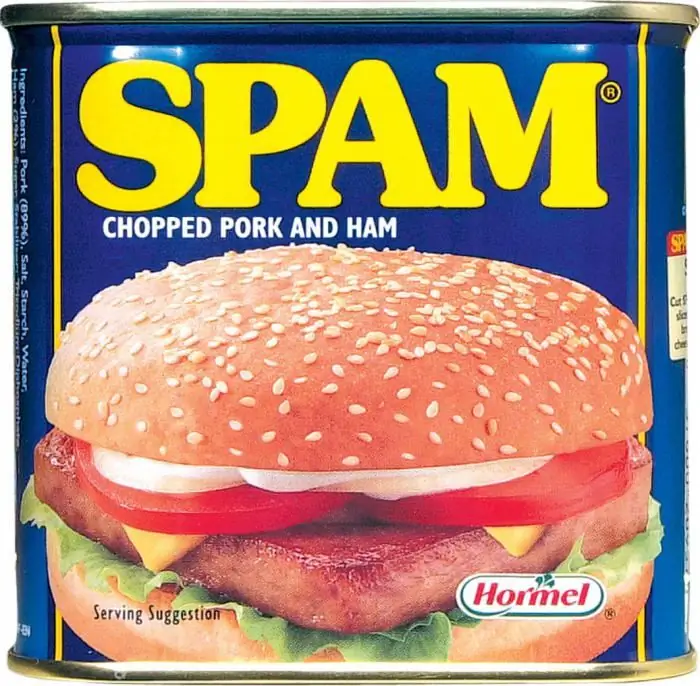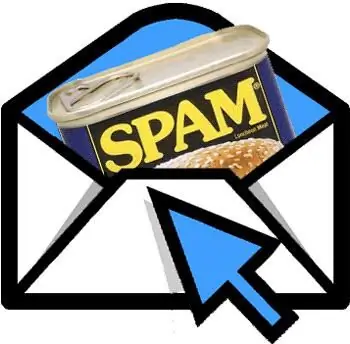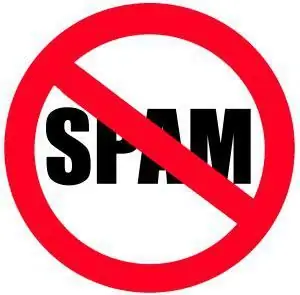Have you received emails with promotional content? Yes? Then you know what spam is. Almost all mail services that exist in the world today allocate a huge amount of funds to combat spam. Developers create a variety of programs and scripts that allow you to detect advertising messages and block them, as well as their senders.
Despite this, these letters continue to come. Some of them are indeed detected and automatically transferred to the Spam folder (every mail provider already has it now); the rest may actually come to the Inbox.
To learn more about what email spam is, why it is sent and how to deal with it, read this article.
What is spam?
In general, the word "spam" comes from the name of spicy minced meat (from pork and beef), the name of which was used in a comedy series in 1971. As planned by the scriptwriter, in one cafe, visitors were so aggressively advertised this product that they literally did not stop using the word "SPAM". The meaning was precisely in the constant, excessive and at the same time aggressive repetition of the specified word.

Today, "spam" is called automated mass mailing of advertising correspondence. Unlike simple advertising, such a mailing does not have a target audience - it is sent to a huge number of people without a specific purpose: simply hoping that some small part of the addressees will be interested in the offer.
In the era of electronic technology, we all know what spam is. In email, SMS, social networks and even in regular mailboxes, we can find a lot of messages that are sent on behalf of certain companies offering their services.
Spam can be very intrusive, and sometimes even dangerous for the recipient. We will talk about this in more detail below. In the meantime, more specifically about those who benefit from such mailings.
Who is spamming?
As already noted, we receive a lot of untargeted promotional offers. All these letters (spam) act most often in the interests of the companies with which they are advertised (suppliers of goods and services that are described in the offer). In some cases, spam mailings can be carried out in order to achieve the opposite effect - to scare away the consumer in order to annoy the competitor.

Of course, if in your mailbox you find a letter with an advertisement for a shoe store, this does not mean that such a mailing is done by the store itself. Most likely, the messages were sent from a special server designed for such purposes. And the store owner could simply order such a newsletter.
Another situation where you trysend spam with a request to transfer money or containing some obviously fraudulent offer. For example, these are the well-known "letters of happiness" that your distant rich relative left millions of dollars as an inheritance, and you are required to pay commissions in the amount of $ 200-300. This type of email is most likely sent by just a group of people who have access to the necessary tools (for example, it can be a spam program, a server and a mailing list).
What are they advertising?
If we talk about what is advertised in spam emails, then this is a huge number of options. The newsletter can promote a particular company, product or service, online store or service. In such a case, of course, the spammers are trying to be covert so as not to harm the service provider. For example, official companies will not spam as it is illegal. They can use a shim site or front store to promote their products.

In other cases, spam may contain links to various sites containing viruses; programs that can harm your computer, pornographic materials, various requests from fake people. Such mailings are carried out just by groups of people who simply earn money in illegal ways. It can even be hackers - specialists with special knowledge in this area.
Is it profitable?
According to unofficial studies, spammers annually earn millions of dollars from their activities. They areadvertise websites for adults, stores with pharmaceuticals, send viruses and various fraudulent messages to millions of people. Imagine that, despite the fact that many are aware of what email spam is and how harmful it can be to the recipient, people continue to believe what is written and send money, buy access to websites, tablets and even install programs.

To be specific, yes - spam is very profitable. Otherwise, they wouldn't be doing it. It's just that the other side of the coin is the question of how difficult it is to send mailings in terms of monetary costs. Indeed, even a non-professional understands that a spam program (or some special script) and servers from which the mailing will be carried out, as well as a host of other technical nuances, are additional costs that need to be recouped from the profits from the messages sent. Therefore, it is impossible to say that spam is a simple activity. A lot of people do this, but only a small part manage to earn really big money here.
Email spam
Spam appeared in e-mail, probably, first of all. Of course, it was a particularly effective tool at the very beginning of the development of Internet technologies. At that time, people still did not know what spam was, what to do with incoming letters, that there really was no inheritance, and you could forget about the money sent to the specified details.

Later, of course, a problemspam attended to mail services. They were forced to introduce the first mechanisms for blocking spammers, which were later successfully unraveled. This is how the anti-spam industry has been working for the past few years: those who send emails come up with something new; and the task of mail services is to create a filter that will prevent letters from reaching users.
All modern Internet companies, including Yandex, are struggling with the phenomenon referred to in this article. Spam has become their main enemy, so the search engine development team has been constantly improving methods for selecting advertising letters for several years now. Their success has been mixed so far as the junk mail keeps coming in.
Spam in other services and services
Besides mail, there are many other services used by spammers. In fact, these are various forums, blogs, regular sites, message boards, social networks, abandoned resources that are no longer being worked on. This indicates that, despite the fight against such a phenomenon, no one knows how to remove spam.
Unless you can learn from the experience of the most technologically advanced players in the IT market - the largest social networks (Facebook, Twitter), where spam is constantly detected and removed. And then - even there you can find a huge amount of hidden (and not so much) spam.
How to fight?
Just the question arises: how to deal with such a negative phenomenon? Is it possible to make browser spam stop annoying ordinary users, who, for the most part,not interested in the products offered?
It is necessary to fight intrusive messages, but it is still impossible to eradicate such a thing as spam. The most effective tools are simply automatic and manual control of what users send to each other, as well as some kind of restrictions that can be used to reduce the growth in the number of spam messages.

For example, in the same Gmail there are filters that reject messages containing links that are sent in large volumes to different people. Such accounts will be blocked very quickly, and spam emails will not reach the recipients.
The problem with this technique is that there are many forms of spam. Roughly speaking, it can be sent not only in the form of links and not from one account. In fact, attackers can create many accounts on different IP addresses in such a way as to hide their real intentions. It will be more difficult for the postal service to detect such activity.
What measures are being taken?
Besides the simple compilation of filters, email services are doing a lot of innovative developments that allow you to recognize spam in one form or another. With their help, users will not think about how to remove spam, and this will make working with mail much more convenient.

However, how such solutions work, why they still miss intrusive advertising messages, no one knows. It's just that in the technology news section, major mail providers sometimes publish information abouttesting new protection mechanisms; and over time, you can see how the number of spam messages really decreases. The working methods of such mechanisms remain a secret.
You received spam. What to do?
If you see an unsolicited email in your mailbox that is clearly advertising (or fraudulent) in nature - do not panic. All you need to do is to click the "Mark as spam" button (if your mail provider has one) in order to inform the service about the promotional nature of the message. If you don't have a "This is spam" button, just delete the email.
In no case do not follow the links indicated there and do not download the attached files! Don't forget what email spam is! It could be a program that can steal your data or infect your computer.
Responsibility for Newsletter
If suddenly you would like to try to send spam yourself, we hasten to warn you that this is a criminally punishable activity, including in our country. Therefore, we do not recommend trying.






